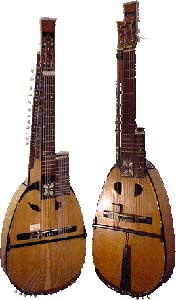
My initial question back in 2004 regarding the Combolin – or actually, pair of Combolins – was of course “Is it a harp guitar or not?” Though the answer turned out to be “definitely not” for one and “possibly” for the other, I have still enjoyed learning a lot more about these curious instruments that I never originally took the time to uncover.
From the site’s beginning, I had this image of the 2 original Combolins included in the Hybrids Forms gallery, due to the appearance of extra floating strings (I really had no idea what they were!). They came from a site, now defunct, called skerriesmusic.com. I was soon asked to remove the photos by David Sinton, a former partner in Skerries Music. It developed that David himself had no issue, and he promised to supply better photos of the instruments for my exclusive use, something that fell through the cracks and never happened. I was, sadly, unaware of David’s unique relationship with the Combolins at the time, and ignorant as to their history, something that every fan of The Corries knows well.
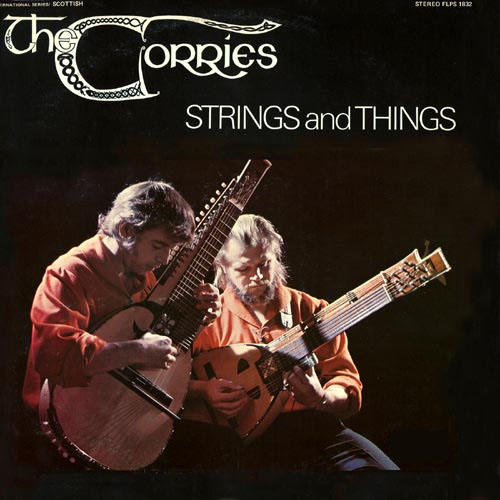
The Corries were a popular Scottish folk group a bit before my time that never crossed my radar. Originally a trio, they ultimately found fame as a duo consisting of singers/multi-instrumentalists Roy Williamson and Ronnie Browne. The duo was said to tour with and play 14 instruments between them. That’s why Roy invented and built for the act the two “Combolins” (“combination of guitar and mandolin”) in the late 1960s. Eschewing a traditional double-neck guitar and mandolin design, Roy came up with the design you see here, a “headless” mandolin (or bandurria) fingerboard cleverly juxtaposed at the end of the main neck. The long strings stretching across the body are not a separate bank of playable strings, but the ends of the mandolin/bandurria strings fanning out to their individual tuners on the edge of the body.
But combining the two necks was just the start. Roy also added sympathetic strings, with a jawari bridge (a la the sitar, or Fred Carlson, if you prefer) to both instruments. They worked to great effect and lent the act quite a distinctive (and rather non-traditional) sound. What’s especially unusual is that one instrument has 13 mid-range, sitar-like buzzing drones, while the other has 4 bass drones. On the recordings, the latter come through quite dramatically!
Roy’s version had a guitar neck tuned open, 13 sympathetic strings (not plucked), and a bandurria fingerboard (like a 6-course mandolin tuned in fourths). Ronnie’s instrument, with the neck tuned standard, had a mandolin fingerboard and the 4 bass strings with a jawari bridge which were plucked like a tanpura for long, vibrating root and fifth notes. A CD compilation liner notes describe these as “moveable slides” to “vary (the strings’) pitch.” While they can be seen in the images and videos, it is hard to know if they were simply “moveable nuts” that “set” 4 open notes that would be plucked for the particular song – or if they could be used as moveable “frets,” for playing simple figures on a given string (I still can’t tell, after listening to the recordings). This detail would answer whether Ronnie’s instrument at least qualifies as a “harp guitar” or not. Irrelevant, of course to a Corries fan!
You can hear the instruments on re-issued recordings of the duo, and on a couple of rare clips of television appearances, such as Jock o’Hazeldine. There are fan’s photo montage videos featuring songs from the old albums as well.
Back to David Sinton. David – with who I originally had only a perfunctory communication – was the guitarist/restorer responsible for keeping the delicate Combolins playing and resonating at their peak. When Roy passed away prematurely in August 1990, he bequeathed the Combolins to David. David took the honor seriously and created combonlins.com (an unfinished website, no longer online), and later spent 2 years completing a charming instrumental album (Caledonian Sunset, 2002) that showcased both Combolins, along with Roy’s 28-string guitar (a 12-string with 16 drone strings) and other instruments. Writing David again recently, I find myself unable to get a hold of him, nor find him on the web, so hope this blog gets his notice. I’ve many more questions and would love to see the Combolins preserved with some better photographs and additional details.
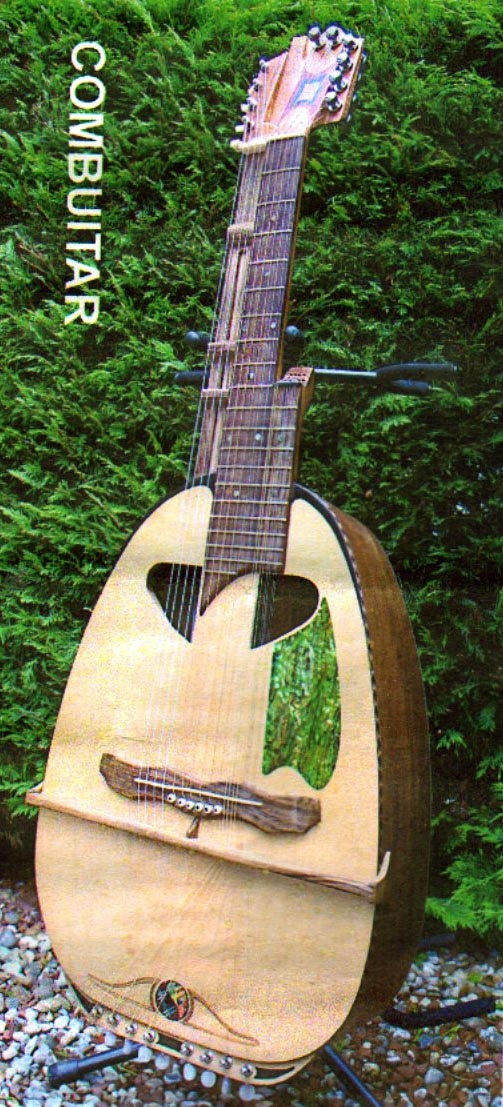
I’m obviously not the only one entranced by these unusual instruments. In 2008 a Corries fan, Benny Tetteh-Lartey, was inspired to build his own version – the Combuitar (at left) – the process of which (and songs on) can be seen on his YouTube channel.
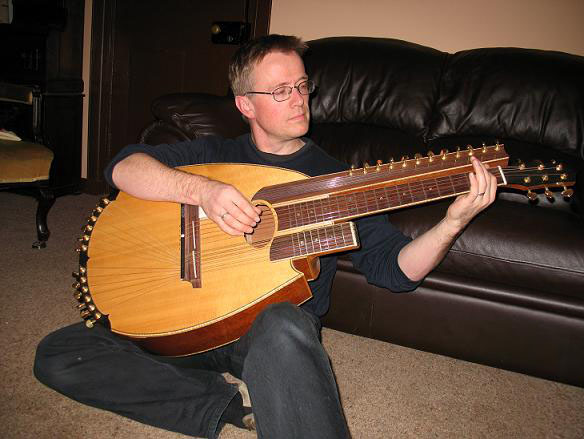
And more recently, roving Harp Guitar Reporter/Googler Benoît stumbled upon a brand new Combolin on the Facebook page of Scottish builder Mark Shiner (above, with his creation). Shiner builds all sorts of interesting instruments at Selkie Strings. This appears to be a more modern version of Roy’s instrument, built for musician Mike Walker (below).
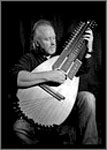 I don’t yet know the story behind this one and hope we’ll hear something from the builder or player one day.
I don’t yet know the story behind this one and hope we’ll hear something from the builder or player one day.
It appears that there may be new life for the inimitable Combolin!

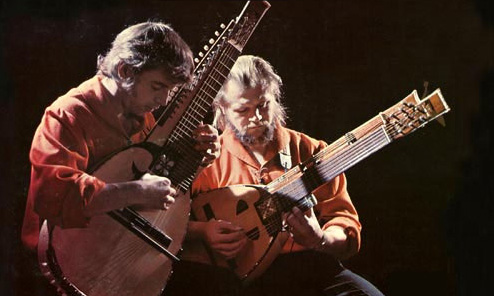
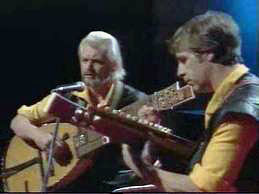
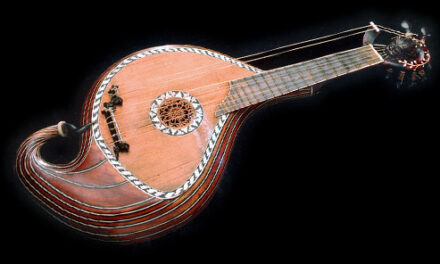
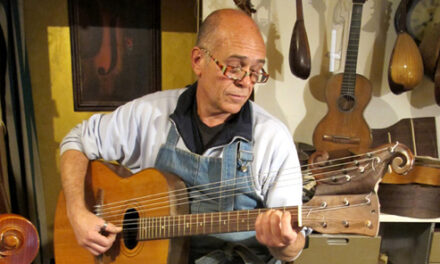
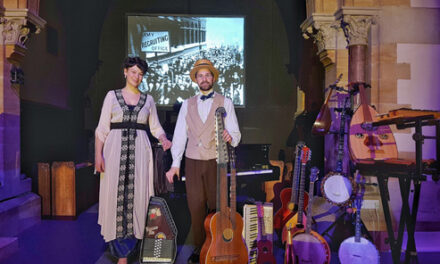
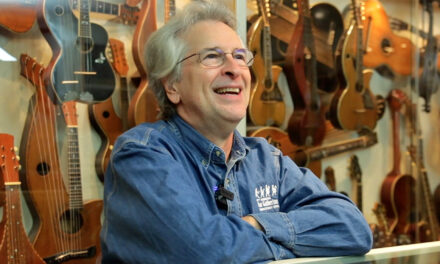
Just out of curiousity, does anyone have a contact for Davie/ Sinton? He fell offf my radar years ago when he was on Uist and haven’t heard a word from or about mim since then.
Would be obliged if anyone could help.
Cheers, Iain (GrumpY)
Hi,
Joining this party a little late I see, but have loved the combolins since I heard Peggy Gordon in 1982. I heard the Corries/combolins live in 1983 and that was something. Last year (2019) I visited Scotland and met Benny Tetteh-Lartey – super nice person – and we sang a song or two together and he let me try the combuitar; I’m a confident player on guitar but I have to say my brain got fried – so many strings that my fingers didn’t know where to go! … but it renewed my interest in the combolin.
I remember speaking with Benny about his (top fretboard) slides – which I think were fixed in place at the time – and he had mentioned difficulty getting answers from Ronnie Browne on how that worked (there are a few videos that show Ronnie using the slides). I have never been able to work out what those are tuned to or how they work. It’s a shame all this info isn’t readily available after all this time. The back of Strings and Things lists the makeup and “4 bass strings” but that’s about it. There was mention above of David Sinton providing some more info – anything come of that?
By the way, whenever the Corries used alternate tunings, it’s Roy’s combolin (the one with the sympathetic strings) – Ronnie’s is always standard tuning!
The Selkie Strings site seems to have gone down late 2016, but I would be very interested in knowing if there are any luthiers out there who can build a combolin.
Speaking of unusual stringed instruments, in Hills of Ardmorn (easy to find on YouTube) the Corries use a big rectangular guitar. What is it?
Hoping there’s still interest in the conversation,
Alan
Reply to D.J. Monroe: You may know by now, but just in case: there are quite a few videos of The Corries on YouTube that show the combolins in action. If you google “The Corries Combolin”, you’ll get a bunch of links. Hope that helps. ~ Linne
In ’72 I found myself in a record shop in Edinburgh, where I picked up an LP of The Corries’ Scottish Love Songs – the shopkeeper had played me the 1st cut side one, and I was sold at the first ‘Hee Ree, Ho Ro’. After years of globetrotting I decided to lighten my load in 2008 (it was either that or buy a large barn) and I got rid of 200 LPs or more, But the Scottish Love Songs and maybe a dozen others I could not part with. I still have most of those songs committed to memory. When I was a marine engineer I would serenade the engines as I checked fluids before lighting them off – usually with ‘Hunting Tower’ or ‘Bonnie Wee Girl’. The sound of the Combolins have touched my soul, and only regret not seeing them perform live – not even seeing a recording of the combolins in play. Thank you for this site, with prayers and hopes the combolins find a new life.
Hello Gregg,
Thank you for your post about the Combolin!
I’ve been obsessed by this instrument for some time now, and would love to commission one to be made.
I have reached out to local luthiers in the US, as well as to Benny Tetteh-Lartey and Mark Shiner about a possible commission. I corresponded with Benny for a bit, and haven’t heard back from Mark after a few e-mails.
Over past few years, have any other luthiers popped up on your radar that might be able to help me make this dream a reality!?
Thanks!
Matt
Mark Shiner of Selkie Strings just now saw the blog and writes, “Hi Gregg, many thanks for your kind inclusion in the blog. I am pleased to put some meat on the bones for you. The instrument I made was for Mike Walker who used to work as a sound engineer with Brian Eno and actually mastered U2’s Joshua Tree album to vinyl. He tells me he still has the original pressings, presumably in a vauilt somewhere!
“Mike had wanted to build a Combolin for some time but eventually gave up and asked me to do it but he kept a close hand on the process and asked to design the battoning pattern for the soundboard. He also very much dictated the outward appearence of the instrument while I was responsible for the “civil engineering”: i.e making sure it didn’t fold in half! Under the bridge I fitted a pair of “Bridge Doctors” available from Stewart MacDonald (stewmac.com) to avoid sound board bowing from new. Everything was engineered up a little, including 1.5 thinknessed sides and back. It is basically a 12-string mandolin, six-string guitar and a neck of sympathetic strings. I kept the necks separate so they could be independently adjusted and to also avoid differential twist. I added a few stylistic elements, such as the curly plate, in ebony, around the bottom bouts.
“I occasionally get asked for quotes to build another but, frankly, I could not do the job justice for less than £2,500 to £3,000 so have never had any repeat business. The issue is really the time it takes to set the thing up, especially with the sympathetic strings. It is basically a sitar inner neck and the guys in India who set the bridges on Sitars do just that task as a full time, highly regarded, job. Building it is just the start, I would need to hang onto it for a few weeks or longer to get it all working properly.
“The instrument has a very resonant, loud, bassy sound. Though I say it myself, it sounds wonderful. Mike is a very lucky man! Please do not hesitate to come back to me if you have any other questions. Thanks again for your inclusion on my work in your blog. Very best wishes, Mark.”
Hey Mark, what are the dimensions you used for the body of your instrument? Did you measure by eye from combolin pictures, and how does one go about determining size if they have no drawings to hand?
I have tried determining by sight the dimensions of another of Roy’s instruments, which is the 28 string guitar, but I don’t know much a great deal about it as its history, build details are a classified matter – David Sinton told me.
David Sinton just replied to my original email, as he was out of the country for a period. At the moment, he is a bit busy, saying: “I’m trying to edit a live recording of John Denver’s band that I did along with a friend, in fact the Corries senior producer. I have been press ganged into doing another Combolin Cd and when that is finished I will get my website up and running. I will be in touch about photographs as soon as I can. Best Regards, Dave”
Gregg, I am visiting Unst and staying at a former RAF radar base called Saxavord; the base has been turned into a holiday resort which has in its visitor centre a display of Corries memorabilia. Both combolins are on display here.